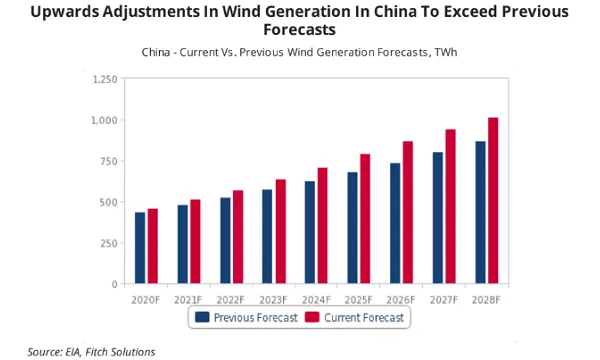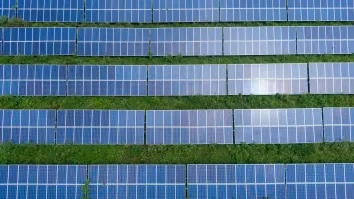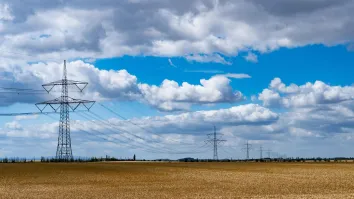
Tech upgrades to push China's wind generation to 700TWh by 2028
Curbing curtailment is also expected to boost the country’s generation capacity.
China is further pushing towards global renewables dominance, thanks to its continued success in curbing curtailment and increasing technology efficiency of power plants and equipment, Fitch Solutions said. According to its new calculations, wind generation is now expected to reach approximately 1,000TWh and solar generation to hit over 700TWh by 2028, compared to their forecasts of 870TWh and 670TWh in the previous quarter.
Fitch Solutions noted the improvements in the efficiency of technology, particularly as it is paramount for developers to drive down project cost. “The decreasing project cost has been at the forefront of the Chinese energy market in recent years due to the phasing out of subsidies over 2020. Manufacturers in the wind industry continue to move towards larger and more efficient commercially deployable turbines, with offshore wind turbines reaching 12MW in size and even larger projects currently in pilot stages,” the team wrote.
The development of larger offshore wind turbines will continue to be a driver for growth in the offshore wind sector, as new turbines will reduce project lifetime cost, making offshore wind more cost-competitive. “This coupled with the fact that the subsidy for China’s offshore wind sector is set to continue a year longer than for the onshore wind sector, we are optimistic for this sector’s growth,” they added.
Solar follows a similar trend in the drive to decrease cost due to subsidy phaseouts. Fitch Solutions noted that several Chinese solar manufacturers are gaining a competitive edge from economies of scale as well as key improvements in product quality. Solar technologies have seen many innovations and advancements across manufacturers with rising competition to develop higher-efficiency PV modules and cells, with Trina Solar achieving a 2019 record of 24.58% efficiency.
Curbing curtailment
Renewables utilisation is expected to rise as China has already taken ambitious steps to curb curtailment. Curtailment has been an issue over the past decade as generation capacity massively outpaced transmission capabilities particularly evident in the western inland provinces and their connection to demand centres.
Two inland provinces, Xinjiang and Gansu, currently stand out in curtailing wind in 2017 by 29% 33%, respectively. “After 2016, curtailment was taken as a serious challenge by the central government and tackled through a combination of transmission optimisation and regulatory and market reform,” Fitch Solutions said.

On a nationwide scale, the Chinese National Energy Administration (NEA) set up reforms in 2017 which considered the issue of curtailment seriously and proposed guiding principles to tackle the problem of wasted generation, those include:
- Strengthening the enforcement and supervision of central government level energy policy over regional markets
- Improving the market to allow improved allocation of resources and encourage renewable consumption
- Improve localised utilisation to the maximum possible and coordination between generation centres and demand hubs
- To increase the efficiency of the power distribution network to achieve highest optimal dispatch conditions for renewables including ever advanced methods
Since the reforms were implemented, Fitch Solutions noticed that grid companies are now mandated to reduce curtailment through the mechanism of guaranteed procurement of renewable sources. “Central government has also included curtailment reduction into provincial authority targets and instituted an ‘alert’ system to monitor new project development of thermal plants and halt plant development if required,” it added.
Flexibility improvements in thermal plant management have also been established in order to give power generation from renewables priority in the grid. Central government and transmission grid companies have developed interprovincial markets for renewables transactions to help send power from generation to demand centres.
“Curtailment of onshore wind generation has fallen from an average of approximately 17% in 2017 to 8% in 2018, and we remain optimistic for further reductions and strengthening in generation output over the coming decade,” Fitch Solutions said.



















 Advertise
Advertise






